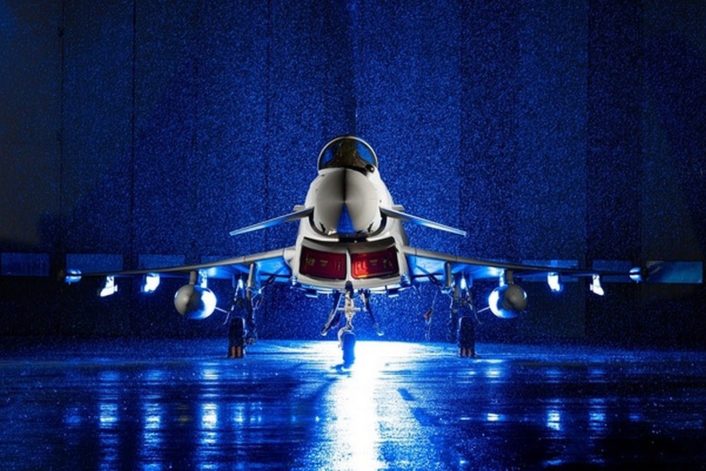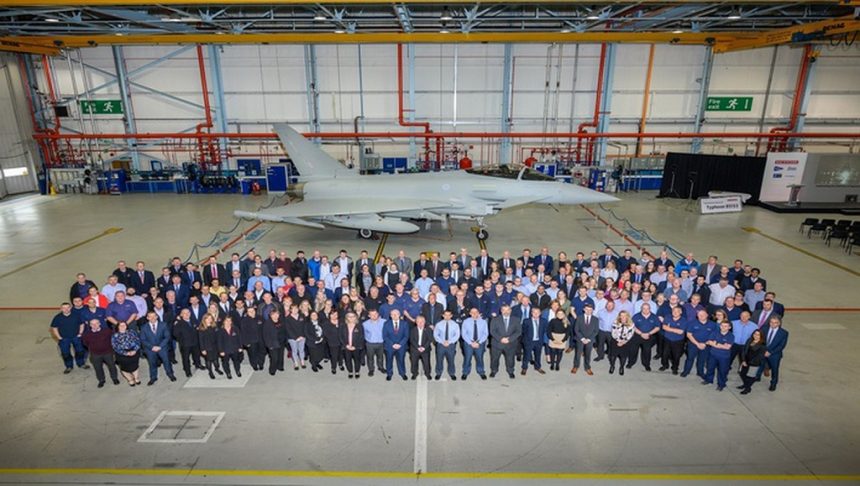The aircraft is the last out of 160 on order and delivered starting from 2003.
As anticipated back in August, on September 27, 2019, the Royal Air Force took delivery of the final Eurofighter Typhoon FGR4 during a ceremony at BAE Systems’ facility in Warton, Lancashire. The aircraft, part of the Tranche 3 contract, is the last of 160 jets bought by the UK and first delivered in 2003. The RAF currently fields eight squadrons in the UK and a permanent detachment in the Falklands equipped with the Typhoon.
During the ceremony, Andy Flynn, Typhoon Capability Director for BAE Systems – Air, said: “This event marks another major milestone in our partnership with the UK which will continue to see us work together to invest in evolving Typhoon to become the complete battlefield controller.”
The EF-2000, initially delivered only with an air defense capability, has been continuously upgraded through the years and a first operational milestone was reached with the Block 5 upgrade, when the aircraft received a basic air-to-ground capability with the integration of GBU-16 Paveway II laser guided bombs and the Litening III targeting pod. This capability was further enhanced by Project Centurion, integrating MBDA’s Meteor, Brimstone and Storm Shadow missiles and Raytheon’s Paveway IV laser guided bombs.

BAE Systems, along with its partners in the Eurofighter consortium, is now working on new upgrades to improve the Typhoon’s capabilities in future operational scenarios with the Long Term Evolution program. Thanks to those upgrades, the Typhoon will be able to work also in conjunction with fifth generation fighters, as already planned by the Royal Air Force and the Italian Air Force that operate both the Typhoon and the F-35 Lightning II in their fleets.
“Typhoon was designed to continuously evolve and its untapped potential continues to be realised with new investments in radar, communications, data management, weapons and connectivity further strengthening its role in the frontline of securing the skies over the UK”, said Flynn about the new upgrades.
The last Eurofighter Typhoon to be delivered to the @RoyalAirForce, BS153/ZK437, on display outside Final Assembly at Warton. Thanks to @BAESystemsAir for the opportunity to get a photo of her! @eurofighter #avgeek pic.twitter.com/SZtVsdJ1Jb
— Matt (@Aero_Fitter) 26 settembre 2019
As we already reported, some of those upgrades could be extended to the Tempest sixth-generation fighter, making them more interoperable. The Typhoon is scheduled to be replaced by the Tempest starting from the 2040s and, considering that the latter’s development is aiming to an operational capability by 2035, the two may need to fly together for some years, thus justifying the need to have them able to cooperate immediately after the Tempest’s introduction in service.
Now that the production for the Royal Air Force is completed, BAE will begin the production of the Typhoons ordered by Qatar, with deliveries beginning in 2022. As I wrote in a previous article:
Typhoons for Kuwait and Qatar are considered the most advanced in production. They will be equipped with the new AESA (Active Electronically Scanned Array) Captor-E radar, produced by the Euroradar consortium, that is being tested in Germany aboard the IPA8 (Instrumented Production Aircraft 8) and will be soon tested aboard IPA5 from Warton. Another sensor that will be tested in Warton in support of this purchase is the Lockheed Martin Sniper targeting pod.









